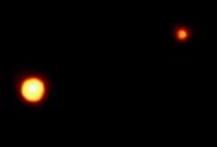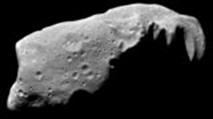Топик: Solar System
NEPTUNE: ROMAN GOD OF WATER
Historical notes
Neptune was discovered in 1846 after mathematical calculations of Uranus' movements predicted the existence of another large body.
Pluto
 Pluto, which is only about two-thirds the size of our moon, is a cold, dark and frozen place. Relatively little is known about this tiny planet with the strange orbit. Its composition is presumed to be rock and ice, with a thin atmosphere of nitrogen, carbon monoxide and methane. The Hubble Space Telescope has produced only fuzzy images (above) of the distant object.
Pluto, which is only about two-thirds the size of our moon, is a cold, dark and frozen place. Relatively little is known about this tiny planet with the strange orbit. Its composition is presumed to be rock and ice, with a thin atmosphere of nitrogen, carbon monoxide and methane. The Hubble Space Telescope has produced only fuzzy images (above) of the distant object.
Pluto's orbit
Pluto's 248-year orbit is off-center in relation to the sun, which causes the planet to cross the orbital path of Neptune. From 1979 until early 1999, Pluto had been the eighth planet from the sun. Then, on February 11, 1999, it crossed Neptune's path and once again became the solar system's most distant planet. It will remain the ninth planet for 228 years.
Pluto's orbit is inclined, or tilted, 17.1 degrees from the ecliptic -- the plane that Earth orbits in. Except for Mercury's inclination of 7 degrees, all the other planets orbit more closely to the ecliptic.
Interestingly, a similar thing happens with Jupiter's moons: Many orbit on the ecliptic, but some are inclined from that plane.
Did you wonder: Will Pluto and Neptune ever collide? They won't, because their orbits are so different. Pluto intersects the solar system's ecliptic, or orbital plane, twice as its orbit brings it "above," then "below" that plane where most of the other planets' revolve -- including Neptune. And, though they are neighbors Pluto and Neptune are always more than a billion miles apart.
Is it a planet at all?
Some astronomers think Pluto may have wandered into the system of planets from a more distant region known as the Kuiper belt -- a region beyond the orbit of Pluto thought to contain Pluto-like objects and comets that orbit the sun in a plane similar to the planets of the solar system.
If that's the case, Pluto is not a planet at all, but is probably more like a large asteroid or comet. Some have also suggested that it may have once been a moon of Neptune and escaped.
The International Astronomical Union, the organization responsible for classifying planets, gives these reasons for questioning Pluto's status as a planet:
- All the other planets in the outer solar system are gaseous, giant planets whereas Pluto is a small solid object
- Pluto is smaller than any other planet by more than a factor of 2.
- Pluto's orbit is by far the most inclined with respect to the plane of the solar system, and also the most eccentric, with only the eccentricity of Mercury's orbit even coming close
- Pluto's orbit is the only planetary orbit which crosses that of another planet (during 1999 Pluto will again cross Neptune's orbit, thus regaining its status as the most distant planet)
- Pluto's satellite, Charon, is larger in proportion to its planet than any other satellite in the solar system.
Pluto has one moon, Charon, which was discovered in 1978. The satellite may be a chunk that broke off Pluto in a collision with another large object.
PLUTO: HADES IN ANCIENT MYTH, ROMAN GOD OF THE UNDERWORLD
Historical notes
Pluto was not discovered until 1930, by amateur American astronomer Clyde Tombaugh. Since Tombaugh's death in 1997, many astronomers have increasingly urged the International Astronomical Union, which names celestial objects, to strip Pluto of its status as a planet.
After a news report generated a flurry of irate e-mails about the possible change, officials assured the world that Pluto would remain a planet. But it will also likely become the first in a new class of celestial object known as a TNO, or Trans-Neptunian Object. It seems Pluto may then have a sort of dual citizenship.
 Comets
Comets
![]() Made of dust, ice, carbon dioxide, ammonia and methane, comets resemble dirty snowballs. You may remember them as blurry smudges in the sky. Comets orbit the Sun, but most are believed to inhabit in an area known as the Oort Cloud, far beyond the orbit of Pluto. Occasionally a comet streaks through the inner solar system; some do so regularly, some only once every few centuries.
Made of dust, ice, carbon dioxide, ammonia and methane, comets resemble dirty snowballs. You may remember them as blurry smudges in the sky. Comets orbit the Sun, but most are believed to inhabit in an area known as the Oort Cloud, far beyond the orbit of Pluto. Occasionally a comet streaks through the inner solar system; some do so regularly, some only once every few centuries.
Heads and tails
As a comet nears the Sun, its icy core boils off, forming a cloud of dust and gas called a head, or coma. Comets become visible when sunlight reflects off this cloud. As the comet gets closer to the sun, more gas is produced.
The gas and dust is pushed away by charged particles known as the solar wind, forming two tails. Dust particles form a yellowish tail, and ionized gas makes a bluish ion tail. A comet's tails, like these on comet Halley, always points away from the Sun.
Meteor showers
When Earth crosses the path of a comet, even if the comet hasn't been around for a few years, leftover dust and ice can create increased numbers of meteors.
Asteroids
 Quick quiz: How many planets orbit our Sun? If you said nine, you're shy by several thousand. Scientists consider asteroids to be minor planets - some are hundreds of miles wide (and seldom round).
Quick quiz: How many planets orbit our Sun? If you said nine, you're shy by several thousand. Scientists consider asteroids to be minor planets - some are hundreds of miles wide (and seldom round).
Orbits
Most, but not all, orbit the sun in an asteroid belt between Mars and Jupiter. The huge gravitational pull of Jupiter accelerated these asteroids to more than three miles per second -- too fast to prevent violent collisions. Otherwise, they might have joined up to form "real" planets. When asteroids collide, fragments sometimes are sent on a collision course with Earth and become meteors.